The Importance of Swim Feet Flippers in Surfboarding
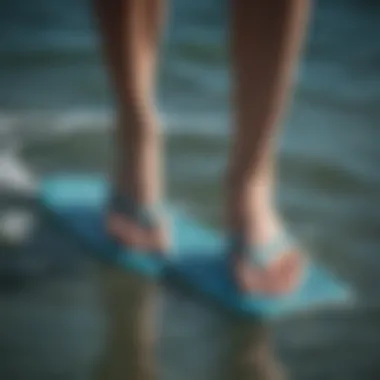
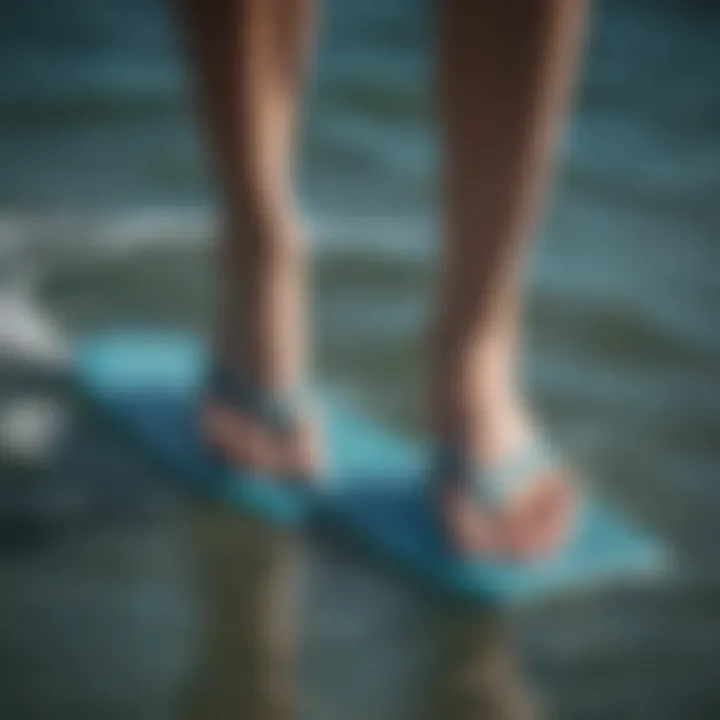
Intro
In the vibrant world of surfboarding, one accessory often goes unnoticed yet plays a significant role in elevating a surfer's performance: swim feet flippers. These flippers are not merely a gimmick; they are tools designed to enhance propulsion, maneuverability, and stability in the water. While many surfers may be fixated on their boards, they must also acknowledge how the right pair of flippers can influence every wave-riding experience.
The primary aim of this article is to dive deep into the essential function of swim feet flippers in surfboarding. We will explore their design intricacies, types available, and various factors influencing the selection process. Further, we will look into the performance benefits they offer in different surf conditions. Our analysis will serve as a guiding beacon for fresh surfers and seasoned pros alike, interested in sharpening their aquatic experience.
Swim Feet Flippers: A Brief Overview
As surfers glide over the waves, the motion of their legs is critical. Flippers amplify this motion and help generate that much-needed speed and control. When you're waiting for that perfect wave, having reliable swim feet flippers can make all the difference.
"A good pair of swim feet flippers can turn the tide, literally and figuratively."
By understanding the various features and advantages of these tools, surfers can make informed choices, ensuring that every ride is as proficient as it is enjoyable.
We'll discuss important aspects like design functionalities, distinctions between beginner and advanced options, as well as practical tips for integrating flippers into your regular surf routine.
So, strap on your flippers as we plunge into the depths of this often-overlooked piece of the surfing equation.
Foreword to Swim Feet Flippers
Swim feet flippers, often just called flippers or fins, hold a significant position in the realm of surfboarding. They are not mere accessories; they are tools that can make a world of difference in the way a surfer interacts with the water. From enhancing speed to providing stability, flippers can amplify a surfer’s ability to navigate waves. This introductory section aims to shine a light on the importance of these devices, emphasizing how they can elevate the performance of both novices and seasoned riders.
Notably, choosing the right flippers can be a game-changer. Each design caters to specific needs and preferences, impacting not just speed but also comfort and maneuverability. Understanding the various elements that define swim feet flippers is crucial for surfers who want to make the most of their time in the water.
Understanding Swim Feet Flippers
In essence, swim feet flippers are designed to be worn on the feet, extending the surface area available for propulsion through water. Their construction often involves materials that are lightweight yet durable, allowing for both flexibility and strength. Most flippers feature a pocket for the foot, providing a secure fit that minimizes any chance of slippage while in action. The blade, or the part that extends outwards from the foot, plays a vital role in how efficiently the flippers work.
Surfers appreciate flippers for their potential to improve power and speed. When kicking with flippers, surfers can generate significant thrust, helping them to paddle out quickly or catch waves with more ease. Unlike swimming fins, which might be optimized for different purposes, flippers specifically aid in surfboarding, where wave dynamics pose unique challenges.
Historical Context
The journey of swim feet flippers began long before they became a staple in surf culture. Initially, their roots can be linked back to ancient Polynesian and Hawaiian traditions where foot mobility in water played a crucial role in everyday activities, from fishing to leisure. Over time, they evolved through practical innovation.
In the mid-20th century, the concept of flippers took a more structured form when several manufacturers experimented with various materials, leading to forms that are now standard in surfboarding. Notably, the development of synthetic rubber opened new doors, creating lighter and more efficient designs. Today's surf fins are an amalgamation of decades of experimentation, reflecting a rich history that has shaped their current iteration.
The continual evolution of swim feet flippers mirrors the advancements not only in surfboarding techniques but also in materials technology. As surfers become more attuned to their preferences and the varying conditions of the surf, flippers only stand to gain a more pivotal role in water sports.
Types of Swim Feet Flippers
When it comes to surfboarding, the choice of swim feet flippers can greatly influence performance. Selecting the right type of flipper is essential for enhancing speed, maneuverability, and overall comfort in the water. Understanding the various types of flippers available can provide surfers with the advantage they need, whether they are carving through calm waters or tackling fierce waves.
Short Blade Flippers
Short blade flippers are designed for efficiency and agility. With a compact size, they allow for quick movements in the water, making them ideal for surfers who thrive on rapid direction changes. The reduced surface area enables a more natural kicking motion and, as a result, can help prevent fatigue during extended sessions. Surfers looking to navigate small to moderate waves often appreciate the responsiveness of short blade flippers.
Key benefits of using short blade flippers include:
- Quick acceleration: These flippers can help in gaining speed rapidly, proving advantageous in swift situations.
- Easier maneuverability: Surfers can adjust their position easily, facilitating agility when surfing.
- Reduced resistance: The shorter blade cuts through the water smoothly, minimizing drag on the feet.
However, there are considerations too. While great for maneuverability, they may not provide the same propulsion as longer counterparts, especially in larger swells.
Long Blade Flippers
Conversely, long blade flippers focus on maximizing propulsion. The elongated surface area allows for powerful kicks, making them suitable for surfers tackling bigger waves where strong thrust is essential. Long blade flippers engage more muscle and can significantly boost a surfer's speed, especially in less turbulent waters.
Some advantages of opting for long blade flippers include:
- Increased power: They generate more thrust, helping surfers paddle out against strong currents more efficiently.
- Enhanced glide: The extended design helps maintain momentum, allowing for smoother rides on longer waves.
- Stability during dives: This type of flipper is effective in keeping the feet stable when navigating through waves or currents.
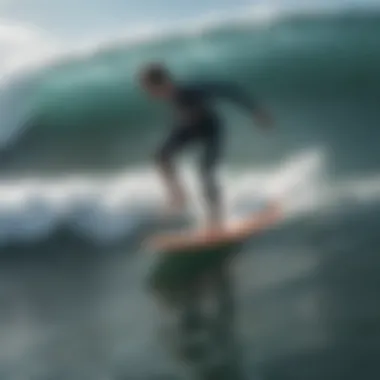
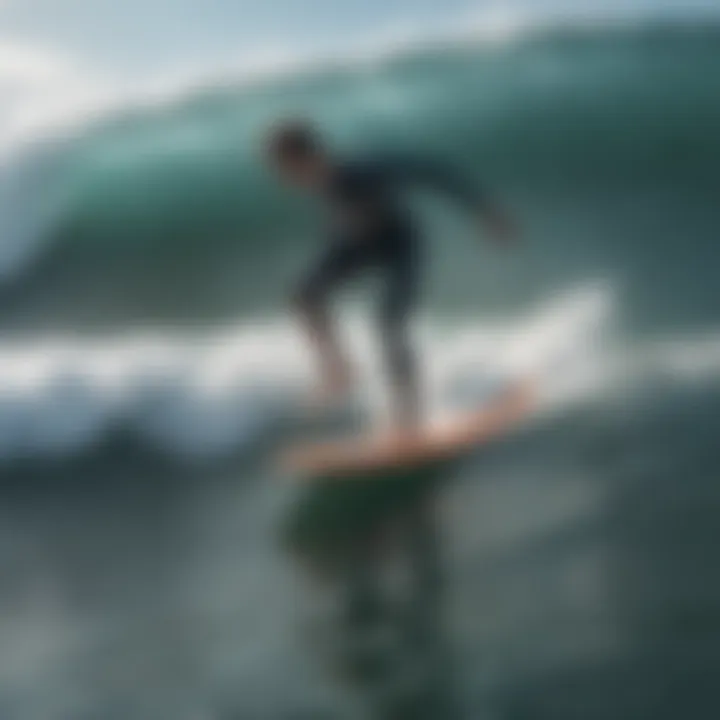
However, they come with their drawbacks. Longer blades tend to be heavier and may cause fatigue over extended periods, especially if the surfer isn't used to them.
Single-Blade vs Double-Blade
When comparing single-blade versus double-blade flippers, it becomes about choice in technique and personal underwater style.
Single-blade flippers have one large blade, generally wider and more robust, which can provide a powerful propulsion push. They require a different kicking style, often employing a more pronounced upward motion. This type may suit surfers focused on maximum thrust and stability, particularly when dealing with significant wave powers.
On the other hand, double-blade flippers come with two blades, allowing for a simultaneous kicking motion, which mimics the natural swimming stroke. They can enhance fluidity and rhythm in movement, which is particularly useful in choppier conditions.
Benefits include:
- Single-Blade:
- Double-Blade:
- Powerful thrust perfect for tough conditions.
- May enhance balance and stability when paddling.
- Offers a more natural feel while kicking.
- Encourages rhythmic pacing.
Ultimately, a surfer's choice between single-blade and double-blade flippers will depend on individual style preferences and the specific surf conditions they encounter. Each type brings advantages that can enhance a surfer’s ability to navigate through waves effectively.
Design and Technology of Flippers
The evolution of swim feet flippers is not mere happenstance; it is rooted in the thoughtful consideration of design and technology. When choosing flippers for surfboarding, it's essential to grasp how their design influences performance in the water. This section elaborates on various aspects—materials and construction, hydrodynamics, and adjustability—that all contribute to their efficacy and the overall surfing experience.
Materials and Construction
Flippers are often made from a variety of materials, each offering distinct benefits. Neoprene, for instance, is a popular choice. It provides both buoyancy and flexibility, allowing for increased comfort during extended periods in the water. Not to mention, its insulation properties can enhance warmth in cooler waters. On the flip side, some flippers utilize rigid thermoplastics to maximize strength while maintaining a minimum weight.
Another pivotal factor in flipper construction is the foot pocket. A well-tailored pocket ensures that the flipper stays securely on the foot without causing discomfort. Surfers often look for additional features such as drainage holes in the foot pockets that help expel water quickly, preventing drag and achieving a more efficient swim.
"It’s not about how fancy the gear looks, but how it enhances performance and comfort in the waves."
Hydrodynamics at Work
The design of swim feet flippers plays a critical role in hydrodynamics. Long and short blades create different levels of thrust and resistance. Short blade flippers, while providing quick propulsion, often require more frequent kicks. In contrast, long blade flippers deliver greater force with each kick, making them ideal for long-distance paddling through surf zones.
The angle of the blade is another notable detail. A more pronounced angle can increase the surface area interacting with the water, enhancing thrust while requiring less effort. Adding a slight curvature to the blade can also facilitate smoother water flow, minimizing turbulence. When all these elements harmonize, surfers experience an unmistakable improvement in stroke efficiency, allowing for seamless transitions between paddling and catching waves.
Adjustability and Fit
Achieving the perfect fit with swim flippers is as crucial as the materials used in their making. Adjustable straps or different sizing options can be a game changer; they cater to the unique foot shape and size of each individual. Having flippers that fit snugly helps prevent blisters and gives confidence when navigating challenging surf conditions.
Additionally, many modern flippers incorporate features such as quick-release buckles or stretchy fabrics that offer ease of use and adaptability. An adjustable design provides the versatility needed to switch between conditions, whether it's a calm bay or turbulent waters. Hence, the combination of fit and adjustability translates to improved performance, ensuring surfers remain focused on the waves ahead, rather than on discomfort or improper gear.
In summary, the intricacies of design and technology in swim feet flippers go beyond aesthetics—they directly impact a surfer's ability and experience on the water. Materials, hydrodynamic principles, and the perfect fit work collaboratively to elevate the average surfing venture into a powerful, efficient ride.
Advantages of Using Swim Feet Flippers
Swim feet flippers are not just accessories; they serve several crucial benefits for surfers, making them essential gear. Regardless if you are just learning the ropes or you have been riding the waves for years, understanding the advantages of these flippers can significantly enhance your surfing experience. Their design contributes not only to performance but also safety and stamina in water. Let’s break down the key advantages of using swim feet flippers in surfing.
Improved Propulsion and Speed
When it comes to speed, swim feet flippers can transform a surfer's performance. The design of these flippers allows for efficient propulsion through water. Unlike swimming bare-footed, flippers provide extra surface area, enabling surfers to push against the water much more effectively.
This extra push translates into higher speeds, especially when paddling out to catch waves. Some surfers might even notice that their ability to navigate through water quickly can save precious time, allowing them to position themselves perfectly for the next big wave. It’s almost like having a turbo boost at your feet, helping maximize every kick.
Conversely, without flippers, surfboard paddling can feel like trying to swim while dragging a heavy rope behind you. The right pair of flippers harnesses the power of the ocean and empowers the surfer to propel forward with ease and efficiency.
Enhanced Stability in Water
Stability in turbulent waters is another prominent advantage of swim feet flippers. Waves can whip up quite a bit of chaos, jostling surfers around and making it hard to maintain balance. Flippers enhance control and stability, giving surfers a solid foundation to maneuver.
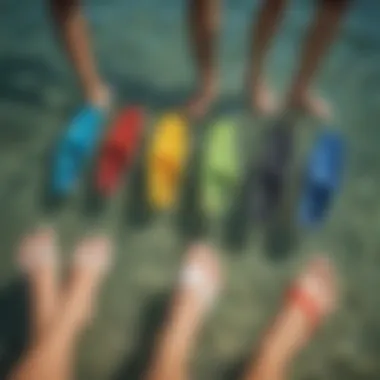
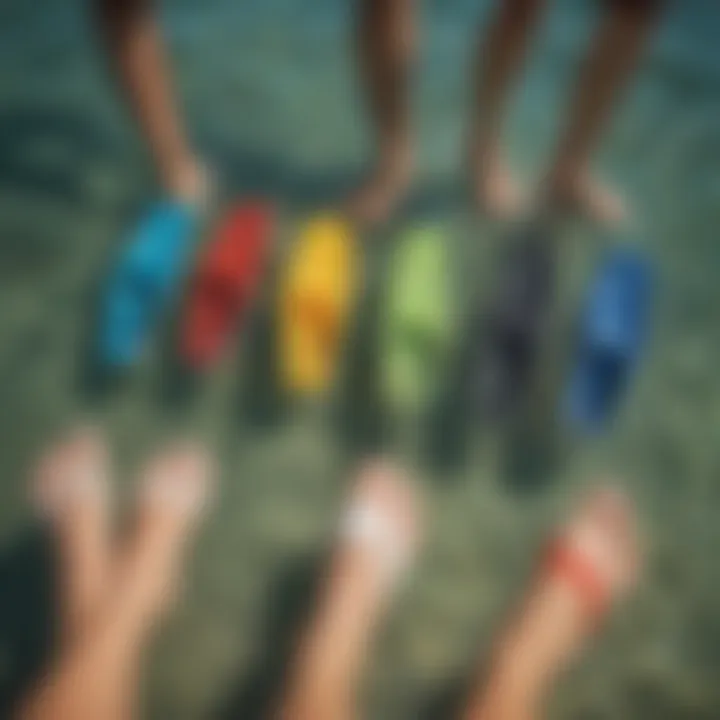
Picture this: you’re out there in the ocean, and a hefty wave approaches. With swim feet flippers, you can quickly adjust your position, keeping your center of gravity low and stable. The added surface area of the flippers allows for better distribution of force with each kick, helping surfers stay upright and properly aligned on their boards. Flippers effectively assist in maneuvering through both calm and choppy waters, making them a fundamental tool for maintaining composure during unexpected situations.
"Using flippers in surf is like a dancer using their shoes - they offer both grace and strength to every move."
Fatigue Reduction During Long Sessions
Surfing can be physically demanding, especially during long sessions. After paddling in and out of waves for a while, fatigue can set in, impacting performance and enjoyment. Here’s where flippers come into play again. By using swim feet flippers, surfers reduce the strain on their legs and feet, allowing them to paddle longer without getting worn out.
Flippers distribute the effort required to move the legs through water. The resulting efficiency means surfers won't tire as quickly as they would without them. It can be a game-changer for those who spend hours in the water; it extends time spent surfing and enhances the overall surfing experience. Flippers can help maintain energy levels, which means more fun and less exhaustion.
In summary, the advantages of using swim feet flippers extend well beyond mere convenience. They enhance propulsion, boost stability, and reduce fatigue, ultimately cultivating a better surfing experience. For anyone serious about their surfing performance, investing in a solid pair of swim feet flippers is a wise move.
Selecting the Right Flipper
Choosing the right swim feet flippers can truly make or break your surfboarding experience. When you're out there on the waves, flexibility, efficiency, and comfort are key. If the flippers don’t align with your needs, it can lead to a whole heap of frustration. With options available that cater to various skill levels and water conditions, knowing how to select the right flipper specifically for you is indispensable.
A poor choice can lead to muscle fatigue, instability, or even injury—things that no surfer wants. A good pair, on the other hand, enhances speed and helps maintain balance without feeling like you’re wearing cement blocks on your feet.
Assessing Individual Needs
Before you even think about plopping down money for any pair of flippers, it's paramount to assess your individual needs. For instance, are you a casual surfer who enjoys leisurely waves, or are you chasing big swells? Understanding your surfing style is crucial. It dictates the blade length and flexibility you need. As a rule of thumb, a shorter blade works wonders for those undertaking casual surfing, while a longer blade might suit those aiming for aggressive speed in larger waves.
It's also wise to consider your strength and stamina. If you're just starting out, heavy-duty flippers may cause unnecessary strain. Conversely, seasoned surfers should look for flippers that provide both power and control. Don't be shy to consult with instructors or other seasoned surfers; their experience can offer priceless insights.
Considerations for Size and Fit
Now, let's talk about size and fit. Picking flippers that fit like a glove can drastically change your surfing game. Too tight, and your feet may cramp up or even develop painful blisters; too loose, and they might slip off at the worst possible moment. Ideally, flippers should hug your feet snugly without pinching.
Many brands offer adjustable straps to ensure a customized fit. Try different sizes and styles—this might mean spending some time at a surf shop, but it’ll be worth it. Some flippers even come with different foot pocket sizes, so make sure to explore those options. Remember, a well-fitting flipper boosts your confidence on the waves.
Evaluating Comfort and Performance
Comfort goes hand in hand with performance. If you're built for long sessions in the water, you want flippers that won't weigh you down. There are various materials available—some are soft and pliable, while others are more rigid and robust. When testing flippers, consider how they feel on your feet. Stand, walk, and even do a few practice kicks.
The right design can also aid your performance. Look for features such as channels that create lift, or contoured blades that promote efficient propulsion. Many experienced surfers also swear by a flipper's buoyancy; lighter flippers can feel less cumbersome, allowing for more freedom in your movements.
"The right swim feet flippers not only enhance performance but also keep comfort levels high, allowing surfers to focus on the waves rather than their gear."
With all these factors combined, you're now better positioned to make an informed decision. Selecting the right flipper isn't just about picking the latest style or brand; it's about understanding how these tools work with your body to enhance your surf experience.
Flippers in Various Surf Conditions
In the dynamic realm of surfboarding, the conditions of the ocean play a pivotal role in shaping the experience. This is where swim feet flippers step in, acting as a surfer's ally. Understanding the nuances of how these flippers perform in varying surf conditions can significantly impact both your safety and enjoyment. From calm waters to turbulent seas, the choice of flipper can either enhance your ride or leave you floundering. Let's dive into the specifics.
Calm Waters versus Choppy Seas
When the ocean is a placid mirror, surfers can glide effortlessly atop the surface, enjoying a leisurely ride. In these calmer conditions, shorter blade flippers may be preferable. They offer less resistance, allowing for a more relaxed paddling style. The reduced drag can give surfers a seamless connection with the water, enhancing the overall experience without unnecessary strain on their limbs. A longer, less flexible blade in these circumstances might work against the surfer, creating unwanted fatigue.
On the flip side, when the waves get choppy, having the right flippers can be the difference between a smooth ride or a frustrating challenge. Here, longer, more robust flippers can provide increased propulsion, allowing surfers to power through rough patches and maintain control. This added thrust is especially useful for catching waves quickly before they break, ensuring you’re in the right place at the right time. However, one must balance maneuverability with power, as overly rigid flippers can become cumbersome when navigating unpredictable waters.
"The choice of swim feet flippers directly influences how surfers can adapt to and navigate changing surf conditions."
Impact of Wave Size
Wave size dictates how surfers approach each session. In smaller swells, a moderate-sized flipper may suffice. These flippers allow for easy movement and quick turns while still providing a bit of push when necessary. As waves grow in size, however, the stakes rise. The challenge becomes not just paddling out but also positioning oneself for the perfect catch. Here, sturdier and longer flippers can amplify velocity, helping surfboard riders paddle through larger swells with greater efficiency.
Conversely, in the biggest of waves, flippers become critical in both propulsion and stability. Surfers often find themselves fighting against powerful currents and the sheer force of the water. In these instances, the right flippers can aid in maintaining balance and minimizing drag, ultimately enhancing performance. Remember, flippers need to match both the conditions of the surf and the user's skill level. A novice might prefer a less aggressive flipper to maintain control, while experienced surfers might opt for designs that maximize speed and power.
Maintenance and Care of Flippers
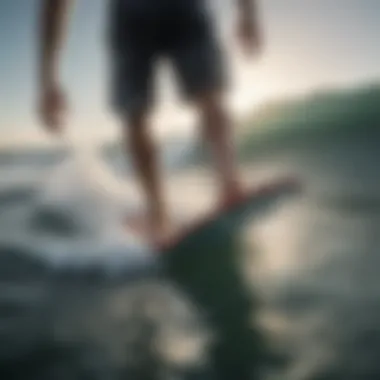
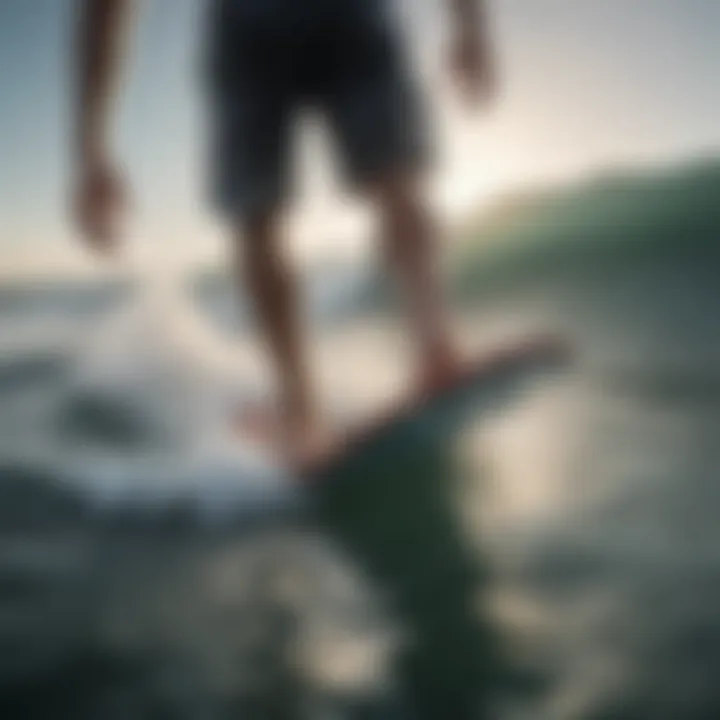
Taking care of swim feet flippers is essential for anyone serious about surfboarding. Flippers, like any equipment, are an investment, and proper maintenance ensures they last long and function at their best. It's not just about avoiding wear and tear; it's about optimizing performance and ensuring safety in the water. When flippers are clean and well-stored, they perform better, and risk factors like injury or malfunction significantly decrease.
Cleaning Procedures
Cleaning your swim feet flippers is a straightforward yet crucial process. After each use, especially in saltwater, rinse them thoroughly with fresh water. This step washes away salt, sand, and other debris that can cause corrosion or deterioration over time. If you're feeling particular about the grime, a mild soap won’t hurt. Just remember to rinse them well after.
Steps for effective cleaning:
- Rinse: Immediately after getting off the water, rinse them under a tap.
- Soap Application: If you've been in especially dirty water, scrub with mild soap using a soft brush.
- Drying: Always allow them to air dry completely before storage; drying them in direct sunlight can warp the material, so shade is better.
Ensure to inspect your flippers for any cracks or excessive wear while cleaning. This can be a good time to spot any issues early on, saving you headaches later.
Storage Best Practices
Where and how you store your flippers can heavily influence their lifespan and effectiveness. Just tossing them into a bag or leaving them in direct sunlight can lead to degradation of materials. Therefore, keeping flippers in a dry, cool place is ideal.
Consider using a mesh bag for storage, allowing for ventilation while keeping them protected from dust and dirt. If you nest your flippers when storing them, be careful not to bend them out of shape, as this may affect their performance.
Best storage tips:
- Cool, Dry Place: Avoid areas with high humidity or direct heat.
- Inspect Before Storing: Look for damage and clean them before putting them away.
- Use a Bag: A proper bag can keep out dust while allowing air flow.
Remember: Proper care isn’t just about longevity; it’s about keeping you safe, comfortable and performing at your best when you’re out on the waves.
In short, a little diligence in cleaning and storage goes a long way in enhancing the quality and durability of your swim feet flippers. Gearing up correctly not only enhances your performance but can also make your time in the water much more enjoyable.
Potential Risks and Considerations
When it comes to using swim feet flippers in surfboarding, it's crucial to shine a light on the potential risks and considerations associated with their use. While these specialized tools undeniably enhance performance and provide numerous advantages, awareness of their downsides can make all the difference in maintaining safety and enjoying the sport to the fullest.
Injury Prevention
Injury prevention cannot be overstated in the world of surfboarding—especially when these flippers are involved. Flippers can lead to a number of risks if not used correctly, which can hinder not just your surfing experience but also your overall health. For instance, if a surfer fails to properly fit their flippers, the likelihood of blisters and abrasions increases significantly, particularly around the ankle and foot areas. Sloppy fits might also lead to cramping, which can spoil even the most thrilling wave.
Moreover, during aggressive maneuvers or wipeouts, flippers can create the potential for collisions. A well-intentioned kick might inadvertently send a flipper flying into another surfer or even back to your own body. To mitigate these risks, ensuring a snug, yet comfortable fit is essential. Regularly inspecting your flippers for damage or wear also stands as a prudent practice.
In addition, beginner surfers should consider practicing with flippers in calmer waters before tackling surf. This can greatly enhance familiarity and comfort. Review local conditions, too, to avoid overcrowded spots where accidents are more likely to occur. Simply put, a little knowledge and a dash of caution can go a long way.
Environmental Considerations
Environmental awareness is increasingly becoming a priority for surfers, especially in an age where ecological impacts are front and center. The choice of swim feet flippers can inadvertently affect marine ecosystems. Many flippers are made from synthetic materials that can lead to environmental concerns, particularly if they are not disposed of responsibly. Over time, as flippers wear out, they can contribute to ocean pollution, which harms marine life.
Furthermore, surfers should be mindful of their activities. The presence of flippers may encourage deeper underwater exploration. In doing so, surfers might encounter fragile habitats such as coral reefs. Kicking too aggressively can harm delicate structures that take decades to form.
To address these concerns, here’s what can be done:
- Choose flippers made from eco-friendly materials, which are increasingly available on the market.
- Maintain a respectful distance from sensitive areas and educate fellow surfers on best practices.
- Support organizations dedicated to protecting marine environments and engage in beach clean-up activities.
The bottom line is: While flippers enhance the surfing experience, surfers hold the responsibility of using them in a way that does not compromise both personal safety and the delicate ecosystems they enjoy.
In summary, with a little foresight and a commitment to safe practices, the joys of surfboarding with swim feet flippers can remain both thrilling and sustainable.
End
The discussion around swim feet flippers brings us to the crux of their significance in surfboarding. These tools are not merely accessories; they are pivotal in enhancing performance, safety, and overall experience in the water. In the sea of options available, understanding how these flippers work can make a world of difference for both seasoned surfers and those just starting out.
From improved propulsion that translates to faster paddling to enhanced stability that fosters confidence in turbulent waters, the benefits are tangible. Moreover, considerations like the environmental impacts and injury prevention add important factors to the mix when choosing the right flippers. Surfing isn’t just about catching waves; it’s about connecting with nature and respecting its boundaries.
The Future of Swim Feet Flippers
As the surfboarding community evolves, so too do the technologies surrounding swim feet flippers. The future holds a landscape where innovation meets sustainability. Designs that incorporate eco-friendly materials without sacrificing performance are gaining traction. Imagine flippers that not only glide through the water but are also made from biodegradable resources.
Furthermore, advancements in smart technology could lead to flippers that provide real-time feedback. With sensors embedded into the flipper’s structure, surfers might be able to monitor their kicking technique or even adjust their propulsion based on wave conditions. This type of enhancement can bridge the gap between physical capability and technological support, potentially revolutionizing how surfers engage with their craft.
"In the next decade, we might see flippers that can adapt to different water conditions in real-time. The performance could be as dynamic as the ocean itself!"
This intersection of technology and surfboarding not only brings excitement but also encourages deeper exploration into personal capabilities. By arming surfers with better tools, we can expect safer and more exhilarating experiences on the waves. Thus, the role of swim feet flippers is poised to remain essential, fostering not just prowess in surfing but also a deeper connection to the ocean.















